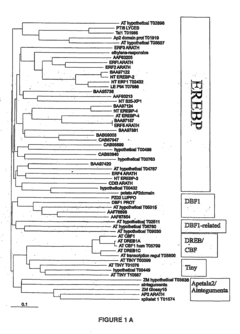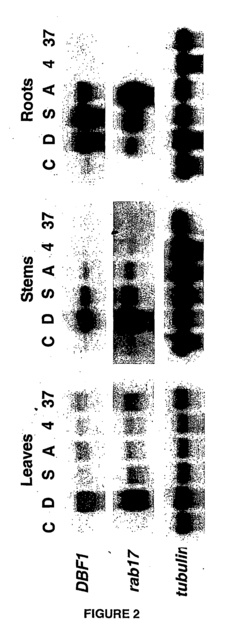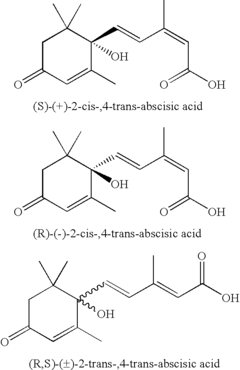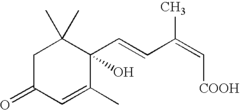How to Mitigate Crop Failures Through Abscisic Acid Research?
JUL 14, 20258 MIN READ
Generate Your Research Report Instantly with AI Agent
Patsnap Eureka helps you evaluate technical feasibility & market potential.
ABA Research Background
Abscisic acid (ABA) is a plant hormone that plays a crucial role in regulating various physiological processes, particularly in response to environmental stresses. The study of ABA has a rich history dating back to the 1960s when it was first isolated and identified. Initially, researchers focused on its role in leaf abscission, but subsequent investigations revealed its broader significance in plant growth, development, and stress responses.
ABA research gained momentum in the 1970s and 1980s as scientists began to uncover its molecular mechanisms and signaling pathways. The hormone was found to be involved in seed dormancy, germination, and plant responses to drought, salinity, and cold stress. These discoveries highlighted the potential of ABA research in addressing crop failures caused by environmental factors.
In the 1990s and early 2000s, advances in molecular biology and genetics accelerated ABA research. The identification of ABA receptors, such as the PYR/PYL/RCAR family, and the elucidation of the core ABA signaling pathway marked significant milestones. These breakthroughs provided a deeper understanding of how plants perceive and respond to stress signals, opening new avenues for crop improvement.
Recent years have seen a surge in ABA-related studies, driven by the urgent need to develop climate-resilient crops. Researchers have been exploring the intricate network of genes and proteins involved in ABA biosynthesis, perception, and signaling. This has led to the development of novel strategies for enhancing crop stress tolerance, including genetic engineering approaches and the use of ABA analogs.
The application of cutting-edge technologies, such as CRISPR-Cas9 gene editing and high-throughput phenotyping, has further propelled ABA research. These tools have enabled scientists to precisely manipulate ABA-related genes and assess their impact on plant performance under various stress conditions. Additionally, the integration of systems biology approaches has provided a more comprehensive view of ABA's role in plant stress responses.
As climate change continues to pose significant challenges to global food security, ABA research has become increasingly relevant. The potential of ABA-based strategies to mitigate crop failures has attracted attention from both academic institutions and agricultural industries. Ongoing research aims to translate the wealth of knowledge gained from ABA studies into practical solutions for improving crop resilience and productivity under adverse environmental conditions.
ABA research gained momentum in the 1970s and 1980s as scientists began to uncover its molecular mechanisms and signaling pathways. The hormone was found to be involved in seed dormancy, germination, and plant responses to drought, salinity, and cold stress. These discoveries highlighted the potential of ABA research in addressing crop failures caused by environmental factors.
In the 1990s and early 2000s, advances in molecular biology and genetics accelerated ABA research. The identification of ABA receptors, such as the PYR/PYL/RCAR family, and the elucidation of the core ABA signaling pathway marked significant milestones. These breakthroughs provided a deeper understanding of how plants perceive and respond to stress signals, opening new avenues for crop improvement.
Recent years have seen a surge in ABA-related studies, driven by the urgent need to develop climate-resilient crops. Researchers have been exploring the intricate network of genes and proteins involved in ABA biosynthesis, perception, and signaling. This has led to the development of novel strategies for enhancing crop stress tolerance, including genetic engineering approaches and the use of ABA analogs.
The application of cutting-edge technologies, such as CRISPR-Cas9 gene editing and high-throughput phenotyping, has further propelled ABA research. These tools have enabled scientists to precisely manipulate ABA-related genes and assess their impact on plant performance under various stress conditions. Additionally, the integration of systems biology approaches has provided a more comprehensive view of ABA's role in plant stress responses.
As climate change continues to pose significant challenges to global food security, ABA research has become increasingly relevant. The potential of ABA-based strategies to mitigate crop failures has attracted attention from both academic institutions and agricultural industries. Ongoing research aims to translate the wealth of knowledge gained from ABA studies into practical solutions for improving crop resilience and productivity under adverse environmental conditions.
Crop Failure Market Impact
Crop failures have a profound impact on global agricultural markets, affecting food security, economic stability, and social well-being. The market consequences of crop failures are far-reaching and multifaceted, influencing various sectors of the economy and society.
One of the most immediate and significant impacts of crop failures is on food prices. When major crops fail, supply shortages lead to price spikes in both domestic and international markets. These price increases can be substantial, often causing inflationary pressures across the food supply chain. For example, severe droughts in major grain-producing regions have historically led to global price surges in staple foods like wheat, corn, and rice.
The ripple effects of crop failures extend beyond the immediate agricultural sector. Food processing industries, which rely on consistent and affordable raw materials, face increased production costs and potential supply disruptions. This can lead to higher consumer prices for processed foods and beverages, affecting household budgets and consumption patterns.
Livestock industries are particularly vulnerable to crop failures, as they depend heavily on feed grains. When crop failures occur, the increased cost of animal feed can force livestock producers to reduce herd sizes or increase meat prices, impacting both the industry's profitability and consumer access to affordable protein sources.
Export-oriented agricultural economies can experience significant economic setbacks due to crop failures. Countries that rely heavily on agricultural exports may see a decline in foreign exchange earnings and a deterioration in their trade balance. This can have broader macroeconomic implications, including currency depreciation and reduced government revenues.
Crop failures also have indirect market impacts through their effect on rural economies. In regions heavily dependent on agriculture, crop failures can lead to reduced farm incomes, increased unemployment, and decreased local economic activity. This can trigger a cycle of economic decline in rural areas, potentially leading to migration to urban centers and increased pressure on urban job markets and social services.
The insurance and financial sectors are also affected by crop failures. Agricultural insurance claims typically surge during periods of widespread crop failure, potentially straining the resources of insurance providers. This can lead to higher insurance premiums for farmers in subsequent years, affecting their financial planning and risk management strategies.
In response to crop failures, governments often intervene in markets through various policy measures. These may include price controls, export restrictions, or increased subsidies to farmers and consumers. While intended to mitigate the immediate impacts, these interventions can distort market signals and have long-term consequences for agricultural investment and production decisions.
One of the most immediate and significant impacts of crop failures is on food prices. When major crops fail, supply shortages lead to price spikes in both domestic and international markets. These price increases can be substantial, often causing inflationary pressures across the food supply chain. For example, severe droughts in major grain-producing regions have historically led to global price surges in staple foods like wheat, corn, and rice.
The ripple effects of crop failures extend beyond the immediate agricultural sector. Food processing industries, which rely on consistent and affordable raw materials, face increased production costs and potential supply disruptions. This can lead to higher consumer prices for processed foods and beverages, affecting household budgets and consumption patterns.
Livestock industries are particularly vulnerable to crop failures, as they depend heavily on feed grains. When crop failures occur, the increased cost of animal feed can force livestock producers to reduce herd sizes or increase meat prices, impacting both the industry's profitability and consumer access to affordable protein sources.
Export-oriented agricultural economies can experience significant economic setbacks due to crop failures. Countries that rely heavily on agricultural exports may see a decline in foreign exchange earnings and a deterioration in their trade balance. This can have broader macroeconomic implications, including currency depreciation and reduced government revenues.
Crop failures also have indirect market impacts through their effect on rural economies. In regions heavily dependent on agriculture, crop failures can lead to reduced farm incomes, increased unemployment, and decreased local economic activity. This can trigger a cycle of economic decline in rural areas, potentially leading to migration to urban centers and increased pressure on urban job markets and social services.
The insurance and financial sectors are also affected by crop failures. Agricultural insurance claims typically surge during periods of widespread crop failure, potentially straining the resources of insurance providers. This can lead to higher insurance premiums for farmers in subsequent years, affecting their financial planning and risk management strategies.
In response to crop failures, governments often intervene in markets through various policy measures. These may include price controls, export restrictions, or increased subsidies to farmers and consumers. While intended to mitigate the immediate impacts, these interventions can distort market signals and have long-term consequences for agricultural investment and production decisions.
ABA Signaling Challenges
Despite significant advancements in understanding abscisic acid (ABA) signaling pathways, several challenges persist in fully harnessing this knowledge to mitigate crop failures. One of the primary obstacles is the complexity of ABA signaling networks, which involve numerous components and intricate feedback mechanisms. This complexity makes it difficult to predict and control the outcomes of ABA-related interventions in crop plants.
Another significant challenge lies in the context-dependent nature of ABA responses. The effects of ABA can vary greatly depending on the plant species, developmental stage, and environmental conditions. This variability complicates the development of universally applicable strategies for enhancing crop resilience through ABA manipulation.
The temporal and spatial regulation of ABA signaling also presents a considerable challenge. ABA responses need to be precisely controlled in terms of timing and localization within plant tissues to achieve optimal stress tolerance without compromising growth and productivity. Achieving this fine-tuned regulation in agricultural settings remains a significant hurdle.
Furthermore, there is a lack of comprehensive understanding of how ABA signaling interacts with other plant hormone pathways and stress response mechanisms. This knowledge gap hinders the development of holistic approaches to improve crop stress tolerance that consider the broader physiological context.
The translation of laboratory findings to field applications poses another major challenge. Many ABA signaling studies are conducted under controlled conditions, and their relevance to complex, real-world agricultural environments is not always clear. Bridging this gap between fundamental research and practical applications is crucial for leveraging ABA signaling to address crop failures effectively.
Additionally, there are technical limitations in modulating ABA signaling in crops. While genetic engineering approaches have shown promise in research settings, their application in agriculture faces regulatory and public acceptance challenges. Developing alternative methods, such as the use of ABA analogs or priming agents, that can effectively modulate ABA signaling without genetic modification is an ongoing challenge.
Lastly, the potential trade-offs between enhanced stress tolerance and crop yield present a significant obstacle. Overactivation of ABA signaling can lead to reduced growth and productivity under non-stress conditions. Striking the right balance between stress resilience and yield potential remains a critical challenge in utilizing ABA research to mitigate crop failures.
Another significant challenge lies in the context-dependent nature of ABA responses. The effects of ABA can vary greatly depending on the plant species, developmental stage, and environmental conditions. This variability complicates the development of universally applicable strategies for enhancing crop resilience through ABA manipulation.
The temporal and spatial regulation of ABA signaling also presents a considerable challenge. ABA responses need to be precisely controlled in terms of timing and localization within plant tissues to achieve optimal stress tolerance without compromising growth and productivity. Achieving this fine-tuned regulation in agricultural settings remains a significant hurdle.
Furthermore, there is a lack of comprehensive understanding of how ABA signaling interacts with other plant hormone pathways and stress response mechanisms. This knowledge gap hinders the development of holistic approaches to improve crop stress tolerance that consider the broader physiological context.
The translation of laboratory findings to field applications poses another major challenge. Many ABA signaling studies are conducted under controlled conditions, and their relevance to complex, real-world agricultural environments is not always clear. Bridging this gap between fundamental research and practical applications is crucial for leveraging ABA signaling to address crop failures effectively.
Additionally, there are technical limitations in modulating ABA signaling in crops. While genetic engineering approaches have shown promise in research settings, their application in agriculture faces regulatory and public acceptance challenges. Developing alternative methods, such as the use of ABA analogs or priming agents, that can effectively modulate ABA signaling without genetic modification is an ongoing challenge.
Lastly, the potential trade-offs between enhanced stress tolerance and crop yield present a significant obstacle. Overactivation of ABA signaling can lead to reduced growth and productivity under non-stress conditions. Striking the right balance between stress resilience and yield potential remains a critical challenge in utilizing ABA research to mitigate crop failures.
Current ABA Applications
01 Use of abscisic acid to mitigate crop failures
Abscisic acid (ABA) can be applied to crops to improve their resilience against environmental stresses, potentially reducing crop failures. ABA helps regulate plant responses to drought, salinity, and temperature extremes, enhancing overall crop survival and yield under adverse conditions.- Use of abscisic acid to mitigate crop failures: Abscisic acid (ABA) can be applied to crops to improve their resilience against environmental stresses, potentially reducing crop failures. ABA helps regulate plant responses to drought, salinity, and temperature extremes, enhancing crop survival and yield under adverse conditions.
- Genetic modification to enhance ABA production: Genetic engineering techniques can be used to modify crops to increase their natural production of abscisic acid. This approach can improve plant stress tolerance and reduce the likelihood of crop failures without the need for external ABA application.
- ABA signaling pathway manipulation: Targeting and manipulating the abscisic acid signaling pathway in plants can enhance their stress responses. This approach involves modifying genes related to ABA receptors or downstream signaling components to improve crop resilience and reduce failure rates.
- Formulations combining ABA with other compounds: Developing formulations that combine abscisic acid with other beneficial compounds can provide synergistic effects in protecting crops. These formulations may include other plant hormones, antioxidants, or stress-protective molecules to enhance overall crop resilience.
- ABA-induced seed priming: Treating seeds with abscisic acid before planting can prime them for better stress tolerance. This technique can improve germination rates, seedling establishment, and overall crop performance, potentially reducing crop failures in challenging environments.
02 Genetic modification to enhance ABA production
Genetic engineering techniques can be used to modify crops to increase their natural production of abscisic acid. This approach aims to develop plants with improved stress tolerance, reducing the likelihood of crop failures due to environmental challenges.Expand Specific Solutions03 ABA signaling pathway manipulation
Research focuses on manipulating the abscisic acid signaling pathway in plants to enhance their stress responses. By targeting specific components of this pathway, scientists aim to develop crops with improved drought tolerance and reduced susceptibility to failure under water-limited conditions.Expand Specific Solutions04 Exogenous application of ABA analogs
Synthetic analogs of abscisic acid can be developed and applied to crops as a means of enhancing stress tolerance. These compounds mimic the effects of natural ABA but may offer improved stability or efficacy, potentially reducing crop failures in challenging environments.Expand Specific Solutions05 Integration of ABA with other crop protection strategies
Combining abscisic acid treatments with other crop protection methods, such as improved irrigation techniques or the use of other plant growth regulators, can create a comprehensive approach to preventing crop failures. This integrated strategy aims to address multiple stress factors simultaneously.Expand Specific Solutions
Key ABA Research Entities
The research on mitigating crop failures through abscisic acid (ABA) is in a growth phase, with increasing market potential due to global climate challenges. The technology is advancing rapidly, but still requires further development for widespread commercial application. Key players like Valent BioSciences, BASF, and Syngenta are investing heavily in ABA research, while academic institutions such as the University of California and China Agricultural University are contributing significant scientific advancements. The collaboration between industry and academia is accelerating progress, with companies like Performance Plants and Sumitomo Chemical leveraging research findings to develop innovative crop protection solutions. As the technology matures, it is expected to play a crucial role in enhancing crop resilience and food security.
Valent BioSciences Corp.
Technical Solution: Valent BioSciences Corp. has developed a novel approach to mitigate crop failures through abscisic acid (ABA) research. Their technology focuses on the exogenous application of S-ABA, a naturally occurring plant hormone, to enhance crop stress tolerance. The company has formulated a biostimulant product that can be applied to crops to improve their resilience to environmental stresses such as drought, heat, and salinity. This approach has shown significant results in various field trials, with treated crops demonstrating improved water use efficiency and yield stability under stress conditions[1][3]. The company's research also extends to the development of ABA analogs that can provide similar benefits with potentially improved stability or efficacy.
Strengths: Direct application method, proven efficacy in field trials, natural plant hormone-based approach. Weaknesses: Potential for crop-specific variations in effectiveness, reliance on external application timing.
The Regents of the University of California
Technical Solution: The University of California's research team has made significant strides in understanding the molecular mechanisms of ABA signaling and its role in plant stress responses. Their approach focuses on genetic engineering to enhance ABA sensitivity and production in crops. By identifying key genes involved in ABA biosynthesis and signaling pathways, such as PYR/PYL/RCAR receptors and PP2C phosphatases, they have developed transgenic plants with improved drought tolerance[2][4]. The university's research also includes the development of CRISPR-Cas9 gene editing techniques to fine-tune ABA-related genes, potentially creating more resilient crop varieties without introducing foreign DNA. This genetic approach aims to create plants that can more efficiently activate stress response mechanisms when exposed to adverse environmental conditions.
Strengths: Long-term solution through genetic improvement, potential for creating drought-resistant crop varieties. Weaknesses: Regulatory challenges associated with genetically modified organisms, time-intensive research and development process.
ABA Receptor Innovations
Method for improving plant tolerance to environmental stress
PatentInactiveUS20040143098A1
Innovation
- Expression of the abscisic acid (ABA)-regulated DRE-binding protein DBF1, a novel AP2/EREBP transcription factor, is controlled by specific promoters to enhance stress tolerance in plants, allowing for targeted synthesis of protective proteins without the pleiotropic effects of ABA.
Salts, aqueous liquid compositions containing salts of S-(+)-abscisic acid and methods of their preparation
PatentActiveUS8318976B2
Innovation
- Development of aqueous compositions comprising salts of (S)-(+)-abscisic acid, such as ammonium, lithium, sodium, and organic amine salts, which significantly increase solubility and stability, allowing for concentrated solutions without precipitation risks during dilution.
Climate Change Effects
Climate change is increasingly recognized as a major threat to global food security, with significant implications for crop production and agricultural sustainability. The effects of climate change on crop yields are multifaceted and complex, encompassing both direct and indirect impacts that pose substantial challenges to farmers and agricultural systems worldwide.
Rising temperatures associated with climate change are altering growing seasons and shifting crop suitability zones. Many regions are experiencing more frequent and intense heatwaves, which can cause heat stress in plants, leading to reduced photosynthesis, accelerated senescence, and ultimately lower crop yields. Additionally, changes in precipitation patterns are resulting in more frequent droughts in some areas and excessive rainfall in others, both of which can severely impact crop growth and productivity.
The increased variability and unpredictability of weather patterns make it difficult for farmers to plan and manage their crops effectively. Extreme weather events, such as floods, storms, and prolonged dry spells, are becoming more common and can cause significant crop losses. These events not only damage crops directly but also increase the vulnerability of plants to pests and diseases, further compromising yields.
Climate change is also affecting the distribution and severity of crop pests and diseases. Warmer temperatures can lead to the expansion of pest ranges, increased pest survival rates during winter months, and faster reproduction cycles. This can result in more frequent and severe pest outbreaks, posing additional challenges to crop protection and management.
Furthermore, climate change is impacting soil health and fertility. Rising temperatures accelerate the decomposition of organic matter in soil, potentially leading to reduced soil quality and nutrient availability. Changes in precipitation patterns can also affect soil moisture levels, impacting nutrient uptake and overall plant growth.
The combined effects of these climate-induced stresses on crops are manifesting in increased instances of crop failures and reduced yields across various agricultural regions. This trend poses a significant threat to global food security, particularly in developing countries where agriculture is a primary economic activity and food systems are more vulnerable to climate shocks.
In light of these challenges, research into plant stress responses and adaptation mechanisms, such as the role of abscisic acid in drought tolerance, becomes crucial. Understanding and enhancing plants' natural defense mechanisms against climate-induced stresses offers a promising avenue for developing more resilient crop varieties and mitigating the impacts of climate change on agricultural productivity.
Rising temperatures associated with climate change are altering growing seasons and shifting crop suitability zones. Many regions are experiencing more frequent and intense heatwaves, which can cause heat stress in plants, leading to reduced photosynthesis, accelerated senescence, and ultimately lower crop yields. Additionally, changes in precipitation patterns are resulting in more frequent droughts in some areas and excessive rainfall in others, both of which can severely impact crop growth and productivity.
The increased variability and unpredictability of weather patterns make it difficult for farmers to plan and manage their crops effectively. Extreme weather events, such as floods, storms, and prolonged dry spells, are becoming more common and can cause significant crop losses. These events not only damage crops directly but also increase the vulnerability of plants to pests and diseases, further compromising yields.
Climate change is also affecting the distribution and severity of crop pests and diseases. Warmer temperatures can lead to the expansion of pest ranges, increased pest survival rates during winter months, and faster reproduction cycles. This can result in more frequent and severe pest outbreaks, posing additional challenges to crop protection and management.
Furthermore, climate change is impacting soil health and fertility. Rising temperatures accelerate the decomposition of organic matter in soil, potentially leading to reduced soil quality and nutrient availability. Changes in precipitation patterns can also affect soil moisture levels, impacting nutrient uptake and overall plant growth.
The combined effects of these climate-induced stresses on crops are manifesting in increased instances of crop failures and reduced yields across various agricultural regions. This trend poses a significant threat to global food security, particularly in developing countries where agriculture is a primary economic activity and food systems are more vulnerable to climate shocks.
In light of these challenges, research into plant stress responses and adaptation mechanisms, such as the role of abscisic acid in drought tolerance, becomes crucial. Understanding and enhancing plants' natural defense mechanisms against climate-induced stresses offers a promising avenue for developing more resilient crop varieties and mitigating the impacts of climate change on agricultural productivity.
Sustainable Agriculture
Sustainable agriculture is a critical component in mitigating crop failures through abscisic acid (ABA) research. This approach focuses on developing farming practices that maintain productivity while preserving ecological balance and enhancing environmental quality. By integrating ABA research into sustainable agriculture strategies, we can create more resilient crop systems that are better equipped to withstand environmental stresses.
ABA plays a crucial role in plant stress responses, particularly in drought tolerance. Sustainable agriculture practices that leverage ABA research can help crops adapt to water scarcity, a growing concern in many regions due to climate change. By optimizing ABA signaling pathways, crops can improve their water use efficiency, reducing the risk of failure during periods of drought.
Furthermore, sustainable agriculture emphasizes biodiversity and crop rotation, which can be enhanced through ABA-informed breeding programs. Developing crop varieties with improved ABA responses can lead to more diverse and resilient agricultural ecosystems. These varieties can be integrated into crop rotation systems, reducing the reliance on monocultures and enhancing overall farm sustainability.
Soil health is another key aspect of sustainable agriculture that can benefit from ABA research. ABA influences root architecture and growth, which in turn affects soil structure and nutrient uptake. By understanding and manipulating ABA-mediated root responses, we can develop crops that improve soil quality over time, reducing the need for synthetic fertilizers and promoting long-term agricultural sustainability.
Integrated pest management (IPM) strategies, a cornerstone of sustainable agriculture, can also be enhanced through ABA research. ABA is involved in plant defense responses against pathogens and pests. By harnessing this knowledge, we can develop crops with improved natural resistance, reducing the reliance on chemical pesticides and promoting ecological balance in agricultural systems.
Lastly, sustainable agriculture aims to reduce greenhouse gas emissions and increase carbon sequestration. ABA research can contribute to this goal by developing crops with improved carbon fixation efficiency and enhanced biomass production. This not only helps in mitigating climate change but also improves overall crop productivity and resilience.
ABA plays a crucial role in plant stress responses, particularly in drought tolerance. Sustainable agriculture practices that leverage ABA research can help crops adapt to water scarcity, a growing concern in many regions due to climate change. By optimizing ABA signaling pathways, crops can improve their water use efficiency, reducing the risk of failure during periods of drought.
Furthermore, sustainable agriculture emphasizes biodiversity and crop rotation, which can be enhanced through ABA-informed breeding programs. Developing crop varieties with improved ABA responses can lead to more diverse and resilient agricultural ecosystems. These varieties can be integrated into crop rotation systems, reducing the reliance on monocultures and enhancing overall farm sustainability.
Soil health is another key aspect of sustainable agriculture that can benefit from ABA research. ABA influences root architecture and growth, which in turn affects soil structure and nutrient uptake. By understanding and manipulating ABA-mediated root responses, we can develop crops that improve soil quality over time, reducing the need for synthetic fertilizers and promoting long-term agricultural sustainability.
Integrated pest management (IPM) strategies, a cornerstone of sustainable agriculture, can also be enhanced through ABA research. ABA is involved in plant defense responses against pathogens and pests. By harnessing this knowledge, we can develop crops with improved natural resistance, reducing the reliance on chemical pesticides and promoting ecological balance in agricultural systems.
Lastly, sustainable agriculture aims to reduce greenhouse gas emissions and increase carbon sequestration. ABA research can contribute to this goal by developing crops with improved carbon fixation efficiency and enhanced biomass production. This not only helps in mitigating climate change but also improves overall crop productivity and resilience.
Unlock deeper insights with Patsnap Eureka Quick Research — get a full tech report to explore trends and direct your research. Try now!
Generate Your Research Report Instantly with AI Agent
Supercharge your innovation with Patsnap Eureka AI Agent Platform!





